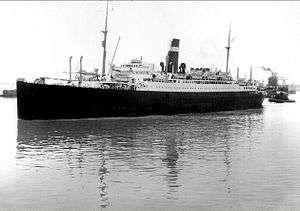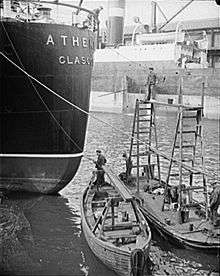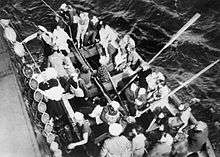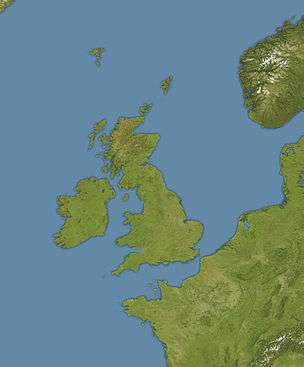SS Athenia
 Athenia in Montreal Harbour in 1933 | |
| History | |
|---|---|
| Name: | Athenia |
| Owner: |
|
| Port of registry: |
|
| Builder: | Fairfield SB & Eng Co, Govan |
| Launched: | 28 January 1922 |
| Completed: | 1923 |
| Identification: |
|
| Fate: | Sunk by U-30, 3 September 1939 |
| Notes: | First UK ship sunk by Germany in World War II |
| General characteristics | |
| Tonnage: | |
| Length: | 526.3 ft (160.4 m) p/p |
| Beam: | 66.4 ft (20.2 m) |
| Depth: | 38.1 ft (11.6 m) |
| Decks: | 3 |
| Propulsion: | 6 × steam turbines; twin screws |
| Speed: | 15 knots (28 km/h) |
| Sensors and processing systems: |
|
| Notes: | sister ship: Letitia |
SS Athenia was a steam turbine transatlantic passenger liner built in Glasgow in 1923 for the Anchor-Donaldson Line, which later became the Donaldson Atlantic Line. She worked between the United Kingdom and the east coast of Canada until September 1939, when a torpedo from a German submarine sank her in the Western Approaches. There were 117 fatalities.
Athenia was the first UK ship to be sunk by Germany during World War II, and the incident accounted for the Donaldson Line's greatest single loss of life at sea. 128 civilian passengers and crew were killed with the sinking condemned as a war crime. The dead included 28 US citizens, leading Germany to fear that the USA might react by joining the war on the side of the UK and France. German authorities denied that one of their vessels had sunk the ship, and the Kriegsmarine did not admit responsibility until January 1946.
Construction
The Fairfield Shipbuilding and Engineering Company of Govan in Glasgow built Athenia, launching her on 28 January 1922 and completing her in 1923. She measured 13,465 GRT and 8,118 NRT, was 526.3 ft (160.4 m) long between perpendiculars by 66.4 ft (20.2 m) beam and had a depth of 38.1 ft (11.6 m). She had six steam turbines driving twin screws via double reduction gearing, giving her a speed of 15 knots (28 km/h).[1] She had capacity for 516 cabin class passengers and 1,000 in 3rd class. By 1930 her navigation equipment included wireless direction finding,[1] and by 1934 this had been augmented with an echo sounding device and a gyrocompass.[2]
Career
Athenia was built for Anchor-Donaldson Line, which was a joint venture between Anchor Line and Donaldson Line. Fairfield built a sister ship, Letitia, which was launched in October 1924 and was completed in 1925. Athenia and Letitia were the two largest ships in Donaldson's various fleets. The ships worked Anchor-Donaldson's trans-Atlantic route linking Liverpool and Glasgow with Quebec and Montreal in summer and to Halifax in winter. After the construction of the Pier 21 immigration complex in Halifax in 1928, Athenia became a more frequent caller at Halifax, making over 100 trips to Halifax with immigrants.[3] In some winter months when there was less trans-Atlantic passenger traffic, Athenia switched to cruising. In 1935 Anchor Line went into liquidation and Donaldson Line bought most of its assets.[4] In 1936 Donaldson was reconstituted as Donaldson Atlantic Line.[5]
Loss

On 1 September 1939 Athenia, commanded by Captain James Cook, left Glasgow for Montreal via Liverpool and Belfast. She carried 1,103 passengers including about 500 Jewish refugees, 469 Canadians, 311 US citizens and 72 UK subjects, and 315 crew.[6] Despite clear indications that war would break out any day, she departed Liverpool at 13:00 hrs on 2 September without recall, and on the evening of the 3rd was 60 nautical miles (110 km) south of Rockall and 200 nautical miles (370 km) northwest of Inishtrahull, Ireland, when she was sighted by the German submarine U-30 commanded by Oberleutnant Fritz-Julius Lemp around 16:30. Lemp later claimed that the fact that she was a darkened ship steering a zigzag course which seemed to be well off the normal shipping routes made him believe she was either a troopship, a Q-ship or an armed merchant cruiser. U-30 tracked the Athenia for three hours until eventually, at 19:40, when both vessels were between Rockall and Tory Island, Lemp ordered two torpedoes to be fired. The first exploded on Athenia's port side in her engine room, and she began to settle by the stern.
Several ships, including the E-class destroyer HMS Electra, responded to Athenia's distress signal. Electra's commander, Lt. Cdr. Sammy A. Buss, was Senior Officer Present and took charge. He sent the F-class destroyer HMS Fame on an anti-submarine sweep of the area, while Electra, another E-class destroyer, HMS Escort, the Swedish yacht Southern Cross, the 5,749 GRT Norwegian tanker MS Knute Nelson,[7] and the US cargo ship City of Flint, rescued survivors. Between them they rescued about 981 passengers and crew. The German liner SS Bremen, en route from New York to Murmansk, also received Athenia's distress signal, but ignored it.[8] City of Flint took 223 survivors to Pier 21 at Halifax and Knute Nelson landed 450 at Galway.

Athenia remained afloat for more than 14 hours, until she finally sank stern first at 10:40 the next morning. Of the 1,418 aboard, 98 passengers[9][10] and 19 crew members were killed.[11] Many died in the engine room and after stairwell, where the torpedo hit.[12] The British crews were famous for putting the passenger's lives before their own, and were expertly trained to handle such "events;" nonetheless, about 50 people died when one of the lifeboats was crushed in the propeller of the Knute Nelson.[13] No. 5A lifeboat came alongside the empty tanker and tied up, against advice, astern of No 12 lifeboat. Only 15 feet (5 m) separated the life boat from the tanker's exposed propeller. Once No. 12 lifeboat was emptied it was cast adrift and began to sink. This fact was reported to the bridge of Knute Nelson. For some reason the ship's engine order telegraph was then set to full ahead. 5A lifeboat's mooring line or "warp" parted under the stress, causing the lifeboat to be pulled back into the revolving propeller.
There was a second accident at about 05:00 hrs when No. 8 lifeboat capsized in a heavy sea below the stern of the yacht Southern Cross, killing 10 people. Three passengers were crushed to death while trying to transfer from lifeboats to the Royal Navy destroyers. Other deaths were due to falling overboard from Athenia and her lifeboats, or to injuries and exposure. Ultimately, all deaths were the result of the U-boat violating orders and torpedoing a merchant passenger liner.
54 dead were Canadian and 28 were US citizens, which led to German fears that the incident would bring the US into the war.[6]
Aftermath

It was not until the Nuremberg Trials after the War that the truth of the U-Boat sinking of the SS Athenia finally came out. The sinking was given dramatic publicity throughout the English-speaking world.[14] The front pages of many newspapers ran photographs of the lost ship along with headlines about the UK's declaration of war. For example, the Halifax Herald for 4 September 1939 had a banner across its front page announcing "LINER ATHENIA IS TORPEDOED AND SUNK" with, in the center of the page, "EMPIRE AT WAR" in outsized red print.
A Canadian girl, 10-year-old Margaret Hayworth,[15] was among the casualties, and was one of the first Canadians to be killed by enemy action. Newspapers widely publicised the story, proclaiming "Ten-Year-Old Victim of Torpedo" as "Canadians Rallying Point", and set the tone for their coverage of the rest of the war. One thousand people met the train that brought her body back to Hamilton, Ontario, and there was a public funeral attended by the mayor of Hamilton, the city council, the Lieutenant-Governor, Albert Edward Matthews, Premier Mitchell Hepburn, and the entire Ontario cabinet.[16]
When Grand Admiral Raeder first heard of the sinking of the Athenia, he made inquiries and was told that no U-boat was nearer than 75 mi (121 km) to the location of the sinking. He therefore told the US chargé d'affaires in good faith that the German Navy had not been responsible. When, on 27 September, U-30 returned to Wilhelmshaven, Lemp reported to Admiral Dönitz that he had sunk the Athenia in error. Dönitz at once sent Lemp to Berlin, where he explained the incident to Raeder. In turn, Raeder reported to Hitler, who decided that the incident should be kept secret for political reasons. Raeder decided against court-martialling Lemp because he considered that he had made an understandable mistake, and the log of the U-30, which was seen by many people, was altered to sustain the official denials.
A month later the Voelkischer Beobachter, the Nazi party's official newspaper, published an article which blamed the loss of the Athenia on the UK, accusing Winston Churchill, then First Lord of the Admiralty, of sinking the ship to turn neutral opinion against Germany. Raeder claimed not to have known about this previous to publication and said that if he had known about it, he would have prevented its appearing.[17]
In the US, 60 per cent of respondents to a Gallup poll believed the Germans were responsible, despite their initial claims that the Athenia had been sunk by the UK for propaganda purposes, with only 9 per cent believing otherwise. Some anti-interventionists called for restraint while at the same time expressing their abhorrence of the sinking. Boake Carter described it as a criminal act.
Some were not completely convinced that Germany was in fact responsible. Herbert Hoover expressed his doubts, saying, "It is such poor tactics that I cannot believe that even the clumsy Germans would do such a thing", while North Carolina senator Robert Rice Reynolds denied that Germany had any motive to sink the Athenia. At best, he said, such an action "could only further inflame the world, and particularly America, against Germany, with no appreciable profits from the sinking." He added that Britain could have had a motive – "to infuriate the American people".[18]
It was not until January 1946, during the case against Admiral Raeder at the Nuremberg trials, that a statement by Admiral Dönitz was read in which he finally admitted that Athenia had been torpedoed by U-30 and that every effort had been made to cover it up. Lemp, who claimed he had mistaken her for an armed merchant cruiser, took the first steps to conceal the facts by omitting to make an entry in the submarine's log, and swearing his crew to secrecy.
After Athenia's sinking, conspiracy theories were circulated by pro-Axis and anti-British circles. For example, one editor in Boston's Italian News suggested the ship had been sunk by British mines and blamed on German U-boats to draw America into the war.[19] The claims were unfounded.
Legality of sinking
As Athenia was an unarmed passenger ship, the attack violated the Hague conventions and the London Naval Treaty of 1930 that allowed all warships including submarines to stop and search merchant vessels, but forbade capture as prize or sinking unless the ship was carrying contraband or engaged in military activity. Even if this was the case, and if it was decided to sink their ship, it was required that passengers and crew must be transferred to a "place of safety" as a priority. Although Germany had not signed the 1930 treaty, the German 1936 Prize Rules (Prisenordnung) binding their naval commanders copied most of its restrictions. Lemp of U-30 did none of these things, choosing instead to fire without warning.
Memorials
The lost British members of Athenia's crew are commemorated at the Tower Hill Memorial in London. Canadian crew who died are listed at the Halifax Memorial (Sailor's Memorial) at Point Pleasant Park in Halifax, Nova Scotia[20] as well as by special plaque for Hannah Baird, a Canadian stewardess who died in the sinking and who is commemorated in a memorial to female merchant mariners in Langford, British Columbia.[21]
Popular culture
No movie has been made of the full story of the sinking, but the film Arise, My Love (1940), directed by Mitchell Leisen and starring Claudette Colbert and Ray Milland, had a sequence involving the torpedoing of the liner.
The song Rollerskate Skinny, written by Rhett Miller and performed by his band The Old 97's, mentions Athenia's sinking.[22]
In John Dickson Carr's novel The Man Who Could Not Shudder, Dr Fell announces the end of story by showing his audience a newspaper bearing headline "LINER ATHENIA: FULL LIST OF VICTIMS". He means to say that the Second World War has begun and the truth of the mystery is now unlikely to surface.
The sinking of the SS Athenia is also mentioned in Alyson Richman's novel The Lost Wife about pre-war Prague and how the dreams of two young lovers are shattered when they are separated by the Nazi invasion, their endurance and experiences during World War II and the Holocaust only to find one another again decades later in the United States.
Recent extensive research concerning the incident appears in Cay Rademacher's 2009 book Drei Tage im September – die letzte Fahrt der Athenia, 1939 published by MareVerlag of Hamburg.
In the novel by Norman Collins, "London Belongs to Me", he describes the sinking of the SS "Anthenia" as war breaks out across Europe. As a result of the sinking, Londoners are in no doubt war has started, and start bracing themselves for what's to come.
Notable individuals aboard
- Andrew Allan, head of CBC Radio Drama, fiancé of Judith Evelyn
- Pax Walker-Fryett, British stage and screen actress
- Hannah Russell Crawford Baird, aged 66,[23] a civilian stewardess from Montreal, who died in the sinking; she was the first Canadian killed in the war[24]
- Barbara Cass-Beggs, British-Canadian teacher, writer and musicologist
- Judith Evelyn, American stage and film actress (Craig's Wife)
- Thomas Eldreth Finley, Jr., head of Loomis Chaffee in Windsor, Connecticut, and his wife, Mildred Shacklett Finley
- James A. Goodson, fighter pilot of the RCAF and later USAAF fighter ace
- Richard Stuart Lake, Former Saskatchewan Lieutenant-Governor and federal politician, and his wife, Dorothy Schreiber Lake
- Charles Prince, Sr. and Charles Prince, Jr. both from Kittery, Maine and employees of the Portsmouth Naval Shipyard
- Nicola Lubitsch, the ten-month-old daughter of film director Ernst Lubitsch (accompanied by a nurse)
- Prof. John H. Lawrence, American physicist and MD, later called father of nuclear medicine, he returned to Berkeley, CA and worked with his brother, Physicist Ernest O. Lawrence
- Gildas Molgat, future Canadian politician (with his father and brothers)
- Elizabeth Lewis and her two children, wife and children of attorney and legal advisor for Warner Bros. Studios, Los Angeles 1939
- James Thornton Mustard, father of Canadian physician and cardiac surgeon William Thornton Mustard
- Daphne Sebag-Montefiore, relation of Moses Montefiore
- Agnes Sharpe, sitting CCF alderman for Hamilton's Ward Eight, second female elected to Hamilton City Council[25]
- Prof. Charles Wharton Stork, American writer and essayist (Day Dreams of Greece)
- Dr. Edward T. Wilkes, a leader in health care for children, an author of several books on pediatrics, and founder and first president of the Pediatrics Society of New York
- Margaretta Drexel, Countess of Winchelsea, wife of Guy Finch-Hatton, 14th Earl of Winchilsea
- Effie Scott Mallery, wife of Addison Mallery, mayor of Saratoga Springs, New York
- Helen Johnson Hannay, daughter of judge Allen Burroughs Hannay
- George Penrose Woollcombe, founder of Ashbury College
- Dr. Lulu Edith Sweigard, colleague of Mabel Elsworth Todd, pioneer of Ideokinesis, author (Human Movement Potential: It's Ideokinetic Facilitation)
- Margaret Doggett, future wife of Trammell Crow and mother of Harlan Crow
- Bill Gadsby, later a Hall of Fame defenseman in the National Hockey League from 1946–66
See also
| Wikimedia Commons has media related to Athenia (ship, 1923). |
References
Footnotes
- 1 2 Lloyd's Register, Steamships and Motor Ships (PDF). London: Lloyd's Register. 1930. Retrieved 4 October 2014.
- ↑ Lloyd's Register, Steamships and Motor Ships (PDF). London: Lloyd's Register. 1934. Retrieved 4 October 2014.
- ↑ "Ship Arrival Database". Canadian Museum of Immigration at Pier 21.
- ↑ Swiggum, Susan; Kohli, Marjorie (3 May 2006). "Donaldson Line". Retrieved 3 October 2014.
- ↑ Cameron, Stuart; Robinson, George; Biddulph, Bruce; Strathdee, Paul. "SS Athenia". Clydebuilt database. Clydesite. Retrieved 3 October 2014.
- 1 2 Johnmeyer, Hillard. "The Sinking Of The Athenia". Something About Everything Military. Retrieved 13 August 2014.
- ↑ Holm Lawson, Siri. "M/S Knute Nelson". Warsailors.com.
- ↑ Brennecke 2003, pp. 15–16.
- ↑ "S.S. Athenia". Commonwealth War Graves Commission. The CWGC puts the number of civilians killed at 64
- ↑ Gregory, Mackenzie J. "Martha Goddard died on the Athenia in Sept 1939". Ahoy – Mac's Web Log.
- ↑ Gregory, Mackenzie J. "SS Athenia, First Casualty of the U-Boat War on the 3 September 1939". Ahoy – Mac's Web Log.
- ↑ Padfield 1996, p. 7.
- ↑ Blair 1996, p. 67.
- ↑ Williams 2003, p. 17.
- ↑ "Hayworth, Margaret Janet". Commonwealth War Graves Commission.
- ↑ Houghton 2003, pp. 75–76.
- ↑ Davidson 1997, p. 381.
- ↑ Doenecke 2003, p. 68.
- ↑ Santosuosso, PA (15 September 1939). "Dear Joe". Italian News. p. 5. (weekly column)
- ↑ "SS Athenia (Glasgow)". Commonwealth War Graves Commission Find War Dead Database.
- ↑ "Hannah Baird". Veterans Affairs Canada.
Virtual War Memorial
- ↑ "Rollerskate Skinny Lyrics".
- ↑ "Stwrdss Hannah Russell Crawford Baird". Findagrave.com.
- ↑ "Nova Scotia House of Assembly Committee on Veterans' Affairs". Hansard. Archived from the original on 13 November 2007. Retrieved 30 October 2007.
- ↑ Fairclough 1995, p. 61.
Sources and further reading
- Blair, Clay (1996). Hitler's U-Boat War. I: The Hunters, 1939–1942. New York: Random House. ISBN 0-304-35260-8.
- Brennecke, Jochen (2003). The Hunters and the Hunted. Annapolis, MD: Naval Institute Press. pp. 15–16. ISBN 1-59114-091-9.
- Cain, Lt Cdr Timothy J (1959). HMS Electra. London: Frederick Miller. ISBN 0-86007-330-0.
- Caulfield, Max (1958). A Night of Terror. London: Pan Books.
- Davidson, Eugene (1997). The Trial of the Germans: an account of the twenty-two defendants before the International Military Tribunal at Nuremberg. Columbia, MO: University of Missouri Press. p. 381. ISBN 0-8262-1139-9.
- Doenecke, Justus D (2003). Storm on the Horizon: The Challenge to American Intervention, 1939–1941. Lanham, MD: Rowman & Littlefield. p. 68. ISBN 0-7425-0785-8.
- Evans, Alan (1990). Orphans of the Storm. Hodder & Stoughton. ISBN 0-340-54414-7.
- Fairclough, Ellen (1995). Saturday's Child: Memoirs of Canada's First Female Cabinet Minister. Toronto: University of Toronto Press. p. 61. ISBN 0-802-007368.
- Houghton, Margaret (2003). The Hamiltonians: 100 Fascinating Lives. Toronto: James Lorimer & Company. pp. 75–76. ISBN 1-55028-804-0.
- Padfield, Paddy (1996). The War Beneath The Sea: Submarine Conflict During World War II. New York: John Wiley & Sons. ISBN 0-471-146242.
- Paine, Lincoln P (1997). Ships of the World: An Historical Encyclopedia. Boston, MA: Houghton Mifflin Harcourt. ISBN 0-395-715563.
- Rademacher, Cay (2009). Drei Tage im September. Hamburg: MareVerlag. ISBN 3-866-480997.
- Williams, Andrew (2003). The Battle of the Atlantic: Hitler's Gray Wolves of the Sea and the Allies' Desperate Struggle to Defeat Them. New York: Basic Books. p. 17. ISBN 0-465-09153-9.
External links
- Allen, Tonya (1995–2014). "The Sinking of the S.S. Athenia". uboat.net. Guðmundur Helgason.
- Jones, Daniel H (2003). "SS Athenia". SMML.
- "Joan Hecht". The Daily Telegraph. 6 September 2009.
- "Ship Name: Athenia Gross Tonnage: 13581". Merchant shipping movement cards 1939–1945. The National Archives.
- "Sinking of SS Athenia". German U-Boats and Battle of the Atlantic. Uboataces.com. 2005–2012.
- IWM Interview with survivor Mary Bauchop
- IWM Interview with survivor Pax Walker-Fryett
Coordinates: 56°44′N 14°5′W / 56.733°N 14.083°W